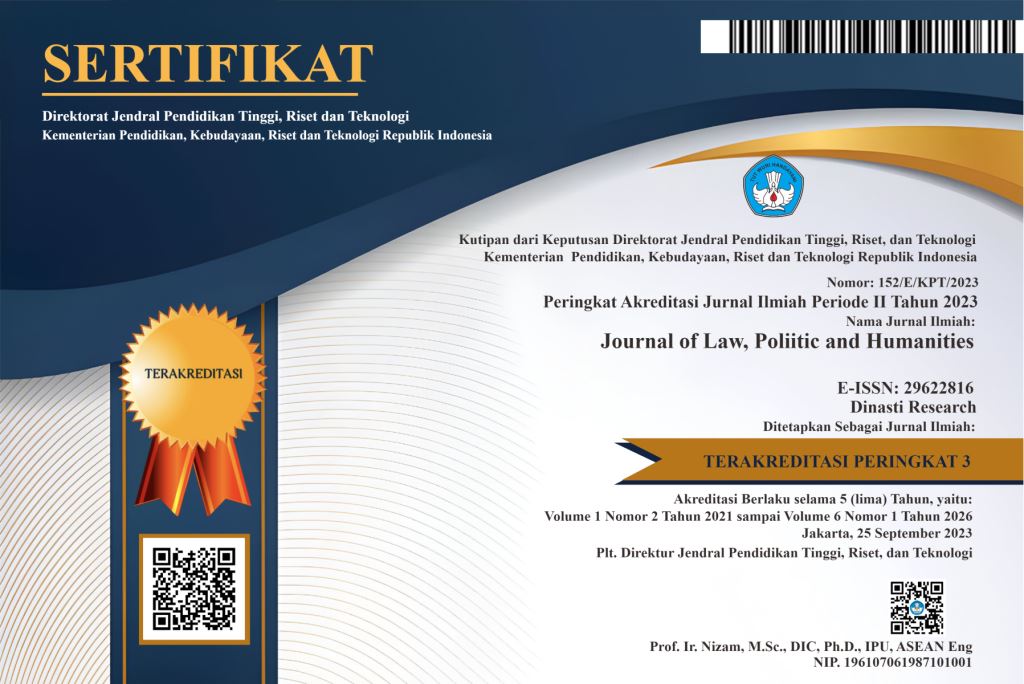The Implementation of Diversion for Juvenile Offenders: A Case Study in the Batu City Police Department
DOI:
https://doi.org/10.38035/jlph.v5i5.1923Keywords:
Children, Child Crime, Diversion, Restorative JusticeAbstract
The juvenile justice system is closely related to the diversion approach as a form of settlement effort for children in conflict with the law. Diversion in this case is a legal effort in resolving cases so that children in conflict with the law can avoid the consequences of judicial procedures which will have a direct impact on the child's psychological and mental state. Based on observations that have been made, in 2024 there have been at least 10 cases of criminal acts involving children as perpetrators in the jurisdiction. The perpetrators of the persecution are known to be 13 years old and in grade 7 of Junior High School (SMP). Diversion as an alternative approach in handling criminal offenses has been seen as an appropriate step to prosecute and guarantee the rights of children in conflict with the law. This research is empirical juridical research using sociological approach and statutory approach. The data used in this research consists of primary data sourced from the results of interviews and observations, as well as secondary data sourced from legal materials in the form of regulations and legislation relevant to the research topic. Data analysis is carried out qualitatively to describe and analyze the application of diversion to juvenile offenders in the Batu Resort Police. The results showed that diversion has not been realized comprehensively in the Batu City Resort Police. The police tend to prefer to use a restorative justice approach rather than diversion because the circumstances in the field do not allow for the application of diversion. Factors that hinder the implementation of diversion in the Batu City Resort Police include individual, procedural, and technical factors. Concrete efforts that have been made by the PPA unit of the Batu City Resort Police to overcome obstacles in the implementation of diversion include the formation of the PPA Task Force in collaboration with various other agencies, such as the Batu City District Attorney's Office, the Batu City Social Service, the Batu City Office of Women's Empowerment, Child Protection and Population Control and Family Planning (DP3AP2KB), the Batu City Education Office, and the Batu City Religious Ministry to socialize the improvement of child protection
References
Aditya Firman Pramudya. 2024. Banit Satreskrim PPA Polres Kota Batu (Narasumber 1).
Ani Purwati. 2020. Keadilan Restoratif Dan Diversi dalam Penyelesaian Perkara Tindak Pidana Anak. Jakad Media Publishing.
Fianty Sibarani, Sasry A. E. Lumban Gaol, dan Afif Fachrurrazi. 2019. “Tindak Pidana Pencurian dalam Keadaan Memberatkan yang Dilakukan oleh Anak Berdasarkan Undang-Undang No. 11 Tahun 2012 tentang Sistem Peradilan Pidana Anak (Studi Putusan No. 74/Pidsus Anak/2015/Pn.Blg).” JURNAL MERCATORIA 12 (1): 29. https://doi.org/10.31289/mercatoria.v12i1.2350.
Irwan Yulianto. 2022. “Prinsip Hukum Diversi terhadap Anak Dalam Perkara Pidana Dengan Pelaku Anak Menurut Undang-Undang Nomor 11 Tahun 2012 Tentang Sistem Peradilan Pidana Anak.” FENOMENA 20 (2): 116. https://doi.org/10.36841/fenomena.v20i2.2396.
Makhrus Munajat. 2023. Hukum Pidana Anak di Indonesia. Sinar Grafika.
Muliadi dan Imam Basofi Usman. 2018. “Efektivitas Pelaksanaan Diversi Terhadap Anak Yang Berhadapan Dengan Hukum (Studi Kasus Di Wilayah Hukum Kepolisian Resort Donggala).” Maleo Law Journal 2 (2): 91–103. https://doi.org/10.56338/mlj.v2i2.767.
Ni Putu Nanik Juniati dan Karyoto. 2023. “Penerapan Diversi pada Tahap Penyidikan terhadap Anak Pelaku Tindak Pidana di Wilayah Hukum Kepolisian Resor Badung.” Jurnal Studi Pemerintahan dan Akuntabilitas 1 (2): 161–69. https://doi.org/10.35912/jastaka.v1i2.1954.
Poppy Novita Ayu dan Heru Susetyo. 2015. “Peran Penyidik Dalam Penerapan Diversi Dan Diskresi Terhadap Anak Yang Berhadapan Dengan Hukum.” Lex Jurnalica 12 (1). https://doi.org/10.47007/lj.v12i1.1344.
Priyanto Puji Utomo. 2024. Banit Satreskrim PPA Polres Kota Batu (Narasumber 2).
R. Wiyono. 2022. Sistem Peradilan Pidana Anak di Indonesia. Sinar Grafika.
Republik Indonesia. 1999. Undang-undang Nomor 39 Tahun 1999 tentang Hak Asasi Manusia. http://peraturan.bpk.go.id/Details/45361/uu-no-39-tahun-1999.
Soemitro, H. 1997. Metode Penelitian Hukum. Jakarta: Ghalia Indonesia.
Sriastuti Agustina. 2019. “Peran Penyidik Dalam Melakukan Diversi Terhadap Anak Sebagai Pelaku Tindak Pidana Dengan Ancaman Pidana Dibawah 7 Tahun (Studi Kasus Di Polres Tulungagung).” Yustitiabelen 2 (1): 20–44. https://doi.org/10.36563/yustitiabelen.v2i1.123.
Suratman dan Philiphs Dillah. 2020. Metode Penelitian Hukum. Cet. ke-4. Bandung: Alfabeta.
Yulianus Pabassing. 2021. “Implementasi Diversi pada Tingkat Penyidikan Sebagai Upaya Pelindungan Anak Yang Berkonflik Dengan Hukum.” Jurnal Ius Publicum 3 (3): 91–106. https://doi.org/10.55551/jip.v3i3.28.
Zainuddin Ali. 2021. Metode Penelitian Hukum. Sinar Grafika.
Downloads
Published
How to Cite
Issue
Section
License
Copyright (c) 2025 Rudi Eko Kurniawan, Sunardi Sunardi, Moh. Muhibbin

This work is licensed under a Creative Commons Attribution 4.0 International License.
Authors who publish their manuscripts in this journal agree to the following conditions:
- The copyright on each article belongs to the author(s).
- The author acknowledges that the Journal of Law, Poliitic and Humanities (JLPH) has the right to be the first to publish with a Creative Commons Attribution 4.0 International license (Attribution 4.0 International (CC BY 4.0).
- Authors can submit articles separately, arrange for the non-exclusive distribution of manuscripts that have been published in this journal into other versions (e.g., sent to the author's institutional repository, publication into books, etc.), by acknowledging that the manuscript has been published for the first time in the Journal of Law, Poliitic and Humanities (JLPH).


























